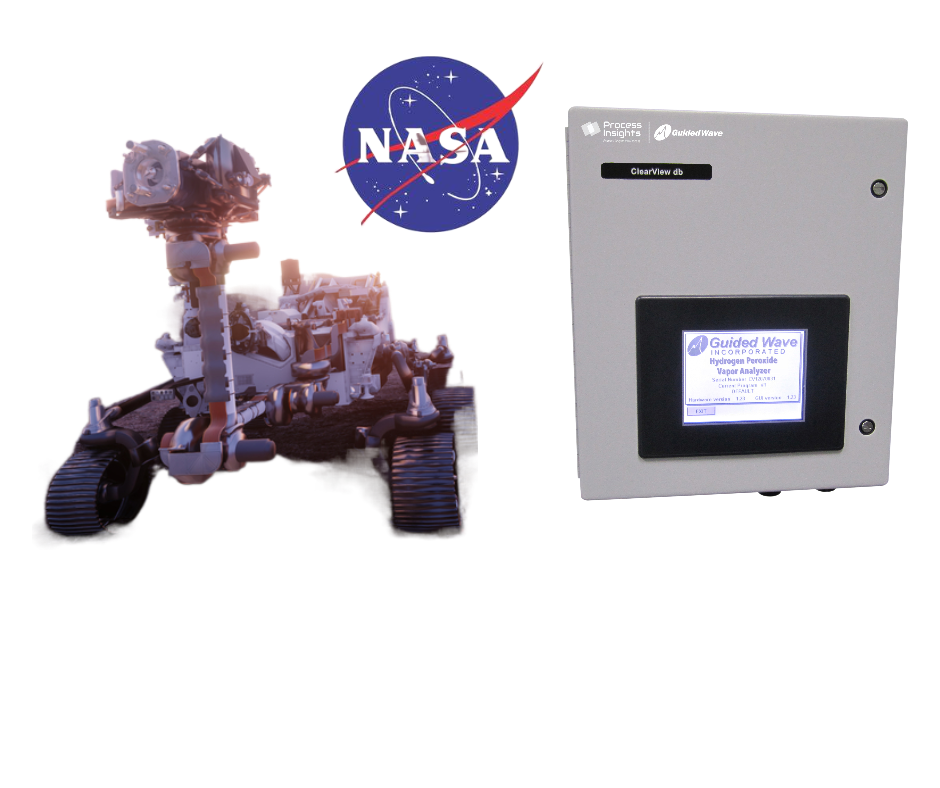Thermally sensitive electronics and hardware on modern spacecraft are not compatible with heat microbial reduction (HMR). As a result, various low temperature vapor phase sterilization methods were considered. Ethylene oxide with Methyl bromide and Formaldehyde with Paraformaldehyde leave organic residue. Consequently, these alternatives are not ideal for organic sensitive hardware. On the other hand, Hydrogen peroxide (H2O2) does not leave organic residue. Oxygen and water are the only by-products. VHP is also cheaper, ideal for heat-sensitive parts, more efficient and takes less time to process than HMR.
The Jet Propulsion Laboratory (JPL) at the Biotechnology and Planetary Protection Group conducted literature review and research work to define process specifications in order to pursue vapor phase hydrogen peroxide (VHP) as an alternative sterilization technique. Quoted from their site,
“During research work, microbes were selected to test the lethality of the technique, including Bacillus stearothermophilus, Bacillus subtilis var. niger, Bacillus pumilus and Bacillus circulans.”
The microbes were deposited on different materials including aluminum, polymer, paint, and epoxied graphite. Following the research work and results, NASA PPO granted approval to use this technique for spacecraft subsystems and systems.
The initial stage for VHP sterilization involves a vacuum chamber where water is evacuated from the environment. In the next stage, H2O2 is injected into the chamber. In the third stage, sterile filtered air is injected into the chamber, which allows H2O2 vapor to penetrate the packaging and diffusion restricted areas to enhance the efficacy of the sterilization process. In the final stages of the process, the chamber is evacuated once more, followed by venting with sterile filtered air: the concentration of hydrogen peroxide vapor returns to ambient levels and the enclosure can be opened to retrieve contents.
NASA PPO has approved the use of VHP as a low-temperature sterilization modality, for simple surfaces, with specifications for time, rate, and H2O2 concentration levels. Complex geometries (e.g., vented boxes and electronic chassis inside the warm electronics box of a rover), however, require further directions. Thus, an additional study aims to describe the effect of VHP on electronic materials, materials with different configurations, solder joints, etc. Work has also begun for developing a portable VHP system that can be used locally (e.g., at the site of hardware integration in a cleanroom or on the launch pad).
Collecting Samples from Mars and the Consequences
For the first time, the Mars 2020 rover, carries a drill that can collect core samples of the most promising rocks and soils. The rover will set them aside in a “cache” on the surface of Mars. A future mission could potentially return these samples to Earth. That would help scientists study the samples in laboratories with special room-sized equipment that would be too large to take to Mars.
The question of “is there life on another planet?’ is an ancient thought. However, the consideration of protecting that life – is a relatively new one. If life does exist on other planets, such as Mars, then we need to consider the consequences of what might occur when material is accidentally or inadvertently transferred between plants. Addressing these consequences is at the forefront of NASA’s Planetary Protection Policy.
NASA’s Planetary Protection Policy and Contamination
NASA, Jet Propulsion Laboratory, California Institute of Technology states,
“Planetary Protection addresses microbial contamination of the solar system by spacecraft that we launch from Earth (forward contamination). This contamination must be prevented in order to preserve the integrity of exploring the solar system; celestial bodies that may have once held an environment suitable for life (e.g., Mars and outer planet icy bodies) are especially vulnerable. Likewise, extraterrestrial contamination of the Earth and Moon (backward contamination), by way of sample return missions, must be prevented. We must approach with caution and preparedness in bringing unknown and potentially dangerous biological materials back to Earth.
While searching for life on the surface of a solar system body (via life-detection instruments) or in future samples returned to Earth, contamination could result in the “false-positive” indication of life. Thus, Planetary Protection’s primary strategy to prevent contamination is to confirm that spacecraft launched from Earth is clean. This precaution ensures that planets, and any life that might be there, remain in their original pristine state for scientific analysis. After the hardware is treated with various forms of microbial reduction, technicians assembling the spacecraft frequently wipe hardware surfaces with an alcohol solution to keep the spacecraft clean. Planetary Protection engineers carefully sample the surfaces and perform microbiology tests to show that the spacecraft meets the specified requirements for biological cleanliness.
In addition to this mission implementation role, the Biotechnology and Planetary Protection Group seeks to develop or adapt modern molecular analytical methods to rapidly detect, classify, and/or enumerate the widest possible spectrum of Earth microbes carried by spacecraft (on surfaces and/or in bulk materials, especially at low densities) before, during, and after assembly, test, and launch operations. Additionally, the group aims to identify new or improved methods, technologies, and procedures for spacecraft sterilization that are compatible with spacecraft materials and assemblies”
From the white paper “The Evolution of Planetary Protection Implementation on Mars Landed Missions “
….”Cleaning and sterilization are distinctly different operations. Sterilization is the process to kill live microbes, while cleaning is a process that physically removes live and dead microbes and debris from hardware surfaces. The most commonly used current spacecraft hardware cleaning methods are precision cleaning and alcohol wiping. While these methods are efficient for cleaning massive contamination, they are not effective for removing micron and submicron-sized microbes and debris from hardware surfaces.
NASA planetary protection regulations state that a surface may be considered “sterile” if a microbial burden of less than 300 aerobic bacterial spores per meter2 can be treated to achieve a 104-fold reduction in viable endospores (spores).” To read the entire paper link here
